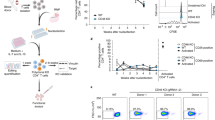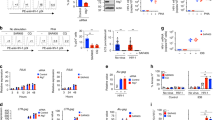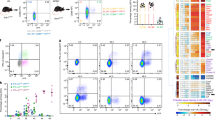Abstract
We describe a novel experimental approach to analyzing virus-host relationships and potential mechanisms of cytopathicity in vivo in simian immunodeficiency virus (SIV) infections. Progressive destruction of lymphoid tissue in the course of infection by SIV or human immunodeficiency virus (HIV) accompanies the loss of CD4+ T lymphocytes and sets the stage for AIDS1,2. Because one of the important early events in this pathological process is lysis of follicular dendritic cells3 (FDCs), we investigated the controversial role of productive SIV infection in the destruction of FDCs. To differentiate productive infections from the known association of virus with FDCs as immune complexes trapped on cell surfaces4–6, we used detection of spliced viral mRNAs in cells as evidence of productive infection. We found that spliced and unspliced viral RNAs could be detected by in situ hybridization (ISH) with specific antisense oligonucleotide probes in lymphocytes and macrophages with sensitivities of fewer than ten copies of spliced viral RNA per cell. We detected only unspliced RNA in germinal centers where FDCs reside. Thus, no productive infection of these cells can be detected in vivo by this assay, and their destruction likely occurs by indirect mechanisms that have yet to be determined.
This is a preview of subscription content, access via your institution
Access options
Subscribe to this journal
Receive 12 print issues and online access
$209.00 per year
only $17.42 per issue
Buy this article
- Purchase on Springer Link
- Instant access to full article PDF
Prices may be subject to local taxes which are calculated during checkout
Similar content being viewed by others
References
Schuurman, H.-J. et al. Lymphocyte status of lymph node and blood in acquired immunodeficiency syndrome (AIDS) and AIDS-related complex disease. J. Pathol. 147, 269–280 (1985).
Diebold, J. et al. Lymph node modification in patients with the acquired immunodeficiency syndrome (AIDS) or with AIDS related complex (ARC). Pathol. Res. Pract. 180, 590–611 (1985).
Klaus, G.G.B., Humphrey, J.H., Kunkl, A. & Dongworth, D.W. The follicular dendritic Cell: Its role in antigen presentation in the generation of immunological memory. Immunol. Rev. 53, 3–18 (1980).
Mandel, T.E., Phipps, R.P., Abbot, A. & Tew, J.G. The follicular dendritic Cell: Long term antigen retention during immunity. Immunol. Rev. 53, 29–59 (1980).
Fox, C.H. et al. Lymphoid germinal centers are reservoirs of human immunodeficiency virus type 1 RNA. J. Infect. Dis. 164, 1051–1057 (1991).
Embretson, J.E. et al. Massive covert infection of helper T lymphocytes and macro-=phages by HIV during the incubation period of AIDS. Nature 362, 359–362 (1993).
Chakrabarti, L., Cumont, M.-C., Montagnier, L. & Hurtrel, B. Variable course of primary simian immunodeficiency virus infection in lymph nodes: Relation to disease progression. J. Virol. 68, 6634–6642 (1994).
Spiegel, H., Herbst, H., Niedobitek, G., F, H.-D., & Stein, H. Follicular dendritic Cells are a major reservoir for human immunodeficiency virus type 1 in lymphoid tissues facilitating infection of CD4+ T-helper Cells. Am. J. Pathol. 140, 15–22 (1992).
Armstrong, J.A. & Home, R. Follicular dendritic Cells and virus-like particles in AIDS-related lymphadenopathy. Lancet 2, 370–372 (1984).
Cameron, P.U., Dawkins, R.L., Armstrong, J.A. & Bonifacio, E. Western blot profiles, lymph node ultrastructure and viral expression in HIV-infected patients: A correlative study. Clin. Exp. Immunol. 68, 465–478 (1987).
Sprenger, R. et al. Follicular dendritic Cells productively infected with immunodeficiency viruses transmit infection to T Cells. Med. Microbiol. Immunol. 184, 129–134 (1995).
Stahmer, I. et al. SIV infection of monkey spleen Cells including follicular dendritic Cells in different stages of disease. J. Acquir. Immun. Defic. Syndr. Hum. Retroviruses 11, 1–9 (1996).
Parmentier, H.K. et al. HIV-1 infection and virus production in follicular dendritic Cells in lymph nodes. Am. J. Pathol. 137, 247–251 (1990).
Stahmer, I. et al. Isolation of normal human follicular dendritic Cells and CD4-independent in vitro infection by human immunodeficiency virus (HIV-1). Eur. J. Immunol 21, 1873–1878 (1991).
Schmitz, J. et al. Follicular dendritic Cells retain HIV-1 particles on their plasma membrane, but are not productively infected in asymptomatic patients with follicular hyperplasia. J. Immunol. 153, 1352–1359 (1994).
Tenner-Racz, K., von Stemm, A.M.R., Gühlk, B., Schmitz, J. & Racz, P. Are follicular dendritic Cells, macrophages and interdigitating Cells of the lymphoid tissue productively infected by HIV?. Res. Virol. 145, 177–182 (1994).
Tsunoda, R., Hashimoto, K., Baba, M., Shigeta, S. & Sugai, N. Follicular dendritic Cells in vitro are not susceptible to infection by HIV-1. AIDS 10, 595–602 (1996).
Murphey-Corb, M. et al. Isolation of a HTLV-III-related retrovirus from macaques with simian AIDS and its possible origin in asymptomatic mangabeys. Nature 321, 435–437 (1986).
Murray, E., Rausch, D., Lendvay, J., Sharer, L. & Eiden, L. Cognitive and motor impairments associated with SIV infection in rhesus monkeys. Science 255, 1246–1249 (1992).
Rausch, D.M. et al. Cytopathologic and neurochemical correlates of progression to motor/cognitive impairment in SIV-infected rhesus monkeys. J. Neuropathol. Exp. Neural. 53, 165–175 (1994).
Viglianti, G.A., Sharma, P.L., & Mullins, J.I. Simian immunodeficiency virus displays complex patterns of RNA splicing. J. Virol. 64, 4207–4216 (1990).
Haase, A.T. et al. Quantitative image analysis of HIV-1 infection in lymphoid tissue. Science 274, 985–989 (1996).
Heath, S.L., Tew, J.G., Tew, J.G., Szakal, A.K. & Burton, G.F. Follicular dendritic Cells and human immunodeficiency virus infectivity. Nature 377, 740–744 (1995).
Peng, H.-R. et al. Single Cell transcript analysis of human immunodeficiency virus gene expression in the transition from latent to productive infection. Virology 206, 16–27 (1995).
Reinhart, T.A., Rogan, M.J. & Haase, A.T. RNA splice site utilization by simian immunodeficiency viruses derived from sooty mangabey monkeys. Virology 224, 338–344 (1996).
Hirsch, V.M., Olmsted, R.A., Murphey-Corb, M., Purcell, R.H. & Johnson, P.R. An African primate lentivirus (SIVsm) closely related to HIV-2. Nature 339, 389 (1989).
Author information
Authors and Affiliations
Rights and permissions
About this article
Cite this article
Reinhart, T., Rogan, M., Viglianti, G. et al. A new approach to investigating the relationship between productive infection and cytopathicity in vivo. Nat Med 3, 218–221 (1997). https://doi.org/10.1038/nm0297-218
Received:
Accepted:
Issue Date:
DOI: https://doi.org/10.1038/nm0297-218
This article is cited by
-
Tools for Visualizing HIV in Cure Research
Current HIV/AIDS Reports (2018)
-
Defining total-body AIDS-virus burden with implications for curative strategies
Nature Medicine (2017)
-
Cell reservoirs in lymph nodes infected with HIV-1 subtype E differ from subtype B: identification by combined in situ polymerase chain reaction and immunohistochemistry
Modern Pathology (2006)
-
HIV-1 and the hijacking of dendritic cells: a tug of war
Springer Seminars in Immunopathology (2005)



